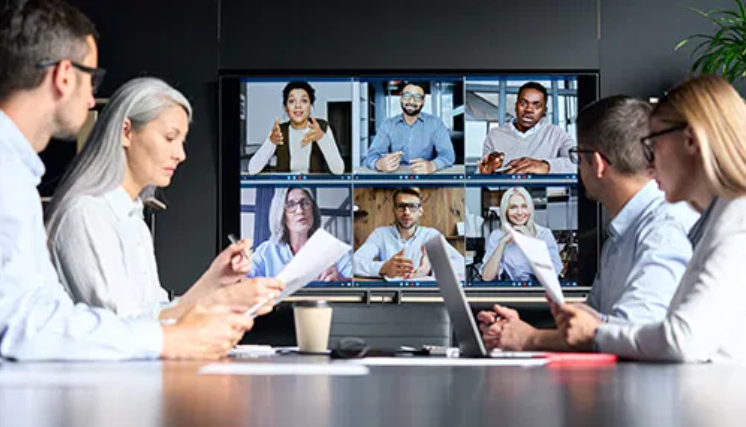Workplace Communication
“When the trust account is high, communication is easy, instant, and effective.” Stephen R. Covey
Importance of Effective Workplace Communication:
Achieving Organizational Goals: Clear communication ensures everyone understands their roles, responsibilities, and the overall objectives of the organization.
Boosting Productivity: When information is shared effectively, employees can work more efficiently and avoid misunderstandings that can lead to wasted time and resources.
Building Trust and Relationships: Open communication fosters a sense of trust and transparency between employees and management, leading to stronger working relationships.
Enhancing Employee Engagement: When employees feel heard and valued, they are more likely to be engaged and motivated in their work.
Improving Customer Service: Effective communication skills are essential for providing excellent customer service, as employees need to understand customer needs and provide accurate information.
Key Elements of Effective Workplace Communication:
Active Listening: Paying attention not just to the words being spoken but also to the underlying message and context,
Clear and Concise Language: Using language that is easy to understand and avoids ambiguity.
Feedback: Providing and receiving constructive feedback to help employees improve their performance and address any issues,
Choosing the Right Channel: Selecting the appropriate communication method for the message, such as face-to-face for complex or sensitive issues and email for routine updates.
Non-Verbal Communication: Being aware of body language, tone of voice, and other non-verbal cues that can impact how a message is received.
Building Relationships: Fostering positive relationships with colleagues through respectful and considerate communication.
Tips for Improving Workplace Communication:
Set Clear Goals and Expectations: Ensure everyone understands what is expected of them and how their work contributes to the overall goals of the organization.
Encourage Two-Way Communication: Create opportunities for employees to share their thoughts and ideas, and actively listen to their feedback.
Provide Training on Communication Skills: Offer workshops and resources to help employees improve their communication skills, including active listening, feedback delivery, and conflict resolution.
Use Technology Effectively: Leverage tools like video conferencing and project management software to facilitate communication and collaboration.
Foster a Culture of Respect: Encourage team members to treat each other with respect, even when they disagree, and to communicate in a constructive and positive manner.


Workplace communication is essential for smooth organizational operations. There are several different types, including verbal communication, which involves meetings, phone calls, and face-to-face interactions, allowing for quick feedback. Nonverbal communication includes body language, facial expressions, and gestures, which are important for conveying messages. Written communication encompasses emails, reports, and memos, where clarity helps avoid misunderstandings. Visual communication uses charts and presentations to support verbal and written messages. Employees should work collaboratively, manage tasks assigned to their roles, and communicate effectively to ensure clarity. Understanding market trends and customer needs is crucial for communication strategies. Key aspects of effective business communication include being clear, concise, complete, concrete, correct, coherent, and courteous. Corporate communication includes public relations, internal communication, and crisis communication to manage perceptions and keep employees informed. Enhance communication, strive for clarity, listen actively, tailor messages to the audience, and seek feedback. Implementing these practices can improve workplace productivity and foster an overall positive workplace atmosphere.
Workplace communication encompasses the various ways employees and management exchange information within an organization. Effective communication is essential for achieving organizational goals, enhancing productivity, and cultivating a positive work environment. It involves both verbal and non-verbal interactions and can be delivered through various channels, including face-to-face conversations, emails, and virtual meetings. Workplace communication is essential for smooth organizational operations. There are several different types, including verbal communication, which involves meetings, phone calls, and face-to-face interactions, allowing for quick feedback. Nonverbal communication encompasses body language, facial expressions, and gestures, all of which play a crucial role in conveying messages. Written communication encompasses emails, reports, and memos, where clarity helps avoid misunderstandings. Visual communication uses charts and presentations to support verbal and written messages. Employees should work collaboratively, manage tasks assigned to their roles, and communicate effectively to ensure clarity. Understanding market trends and customer needs is crucial for communication strategies. Key aspects of effective business communication include being clear, concise, complete, concrete, correct, coherent, and courteous.
Challenges in the Workplace
"Communication is the solvent of all problems and is the foundation for personal development." Unknown.
Conflict Resolution
Conflict is inevitable in any workplace, but how we handle it can make all the difference. Effective communication skills in conflict situations can help de-escalate tensions and find common ground. Sometimes, bringing in a neutral party for mediation and negotiation techniques can provide a fresh perspective and facilitate a resolution that benefits everyone involved. Effective communication fosters a sense of unity among team members, enabling them to work together towards common goals. By sharing ideas, feedback, and information transparently, team collaboration becomes more streamlined and productive. When communication flows smoothly in the workplace, tasks are completed more efficiently, and projects are executed with precision.
The foundation of successful conflict resolution lies in developing emotional intelligence and active listening skills that allow individuals to understand not just what is being said, but the underlying emotions and motivations driving the disagreement. Effective communicators in conflict situations practice empathy by acknowledging different perspectives and validating concerns, even when they disagree with the proposed solutions. This approach helps create psychological safety where all parties feel heard and respected, making them more willing to engage in collaborative problem-solving rather than defensive positioning. Training employees in these fundamental communication skills can significantly reduce the escalation of workplace conflicts and improve overall team dynamics.
Proactive conflict resolution also involves establishing clear communication protocols and expectations before tensions arise. Organizations that invest in conflict resolution training and create structured processes for addressing disagreements often see improved workplace satisfaction and productivity. This includes teaching employees how to give and receive constructive feedback, how to separate personal reactions from professional issues, and how to focus discussions on specific behaviors and outcomes rather than personality traits. When conflict resolution becomes part of an organization's communication culture, employees feel more confident addressing issues early before they escalate into major problems that can damage relationships and impact performance.
Cultural Considerations in Workplace Communication
When it comes to workplace communication, one size does not fit all. Understanding cultural norms is crucial in a diverse environment. What may be considered direct feedback in one culture could be seen as confrontational in another. Adapting communication styles to accommodate different cultural backgrounds shows respect and fosters better relationships among team members. When it comes to workplace communication, one size does not fit all. Understanding cultural norms is crucial in a diverse environment, and what may be considered direct feedback in one culture could be seen as confrontational in another. Adapting communication styles to accommodate different cultural backgrounds shows respect and fosters better relationships among team members.
Cross-cultural communication competency extends beyond simply avoiding offensive language or gestures to understanding deeper cultural values around hierarchy, decision-making, and relationship building. Some cultures prioritize indirect communication that preserves harmony and allows individuals to save face, while others value straightforward, explicit communication that gets directly to the point. Power distance variations mean that some team members may be uncomfortable challenging authority figures or speaking up in group settings, while others expect open debate and discussion. Successful global organizations invest in cultural competency training that helps employees recognize these differences and develop flexible communication strategies that can bridge cultural gaps effectively.
The increasing prevalence of remote and hybrid work environments has made cultural considerations in workplace communication even more complex and important. Virtual communication can strip away many cultural context clues that people rely on in face-to-face interactions, making it more challenging to navigate cultural differences effectively. Time zone variations, religious observances, and cultural holidays all impact communication patterns and availability, requiring teams to develop inclusive practices that accommodate diverse schedules and customs. Organizations that embrace cultural diversity in their communication practices often discover that this inclusivity leads to more innovative solutions, broader market understanding, and stronger employee engagement across all cultural backgrounds.
In a world where emojis and GIFs have become our second language, technology has revolutionized how we communicate at work. Virtual communication tools like Slack, Zoom, and Microsoft Teams have made it easier to collaborate across teams and time zones. No more awkward phone tag or endless email chains—the era of instant messaging and virtual meetings is here to stay. And let's not forget about email etiquette; remember, all caps is the digital equivalent of shouting, so use it sparingly!
The rapid adoption of digital communication platforms has also transformed the speed and expectations around workplace responses. Modern employees navigate multiple communication channels simultaneously, from instant messages requiring immediate attention to emails that allow for more thoughtful responses. This technological shift has created new challenges around work-life balance, as the constant connectivity can blur the boundaries between professional and personal time.
Organizations are increasingly recognizing the need to establish digital communication policies that promote both efficiency and employee well-being, including guidelines for after-hours messaging and response time expectations. However, the digital revolution in workplace communication comes with its own set of pitfalls and learning curves. Non-verbal cues that were once essential parts of face-to-face communication are often lost in digital formats, leading to potential misunderstandings and misinterpretations. The informal nature of many digital platforms can sometimes result in overly casual communication in situations that require a more professional tone and structure. Additionally, the phenomenon of "Zoom fatigue" and screen overload has highlighted the importance of balancing digital efficiency with meaningful human connection, prompting many organizations to reconsider when virtual communication is most appropriate versus when in-person interaction remains irreplaceable.


The AI Revolution
"AI is the ultimate amplifier of human intelligence. It's not about replacing humans, but augmenting their capabilities," Arvind Krishna
The AI revolution represents one of the most transformative technological shifts in human history, fundamentally altering how we work, learn, communicate, and solve complex problems. This multifaceted phenomenon encompasses breakthroughs in machine learning, natural language processing, computer vision, and automated decision-making systems that are being integrated across virtually every sector of society. From healthcare diagnostics that can detect diseases with superhuman accuracy to autonomous vehicles that promise to revolutionize transportation, AI technologies are creating unprecedented opportunities for innovation and efficiency. The revolution extends beyond mere automation of routine tasks to encompass creative endeavors, scientific discovery, and complex reasoning that was once considered uniquely human. Financial markets are being reshaped by algorithmic trading, education is being personalized through adaptive learning systems, and scientific research is accelerating through AI-powered hypothesis generation and data analysis. This transformation is not just about individual applications but about creating interconnected systems that can learn, adapt, and optimize in real-time, fundamentally changing the fabric of how societies function and evolve.
The displacement of traditional employment roles raises critical questions about economic inequality and the need for comprehensive retraining programs and social safety nets. Privacy concerns have intensified as AI systems require vast amounts of personal data to function effectively, creating tensions between innovation and individual rights. The concentration of AI capabilities in the hands of a few major corporations and nations raises geopolitical concerns about technological sovereignty and democratic governance. Additionally, issues of algorithmic bias, transparency, and accountability have emerged as AI systems make increasingly consequential decisions in areas like criminal justice, hiring, and healthcare. The potential for AI to be weaponized or to create new forms of misinformation and social manipulation adds another layer of complexity to this revolution. As we stand at this inflection point, the choices we make regarding AI development, regulation, and deployment will determine whether this revolution becomes a force for widespread human flourishing or exacerbates existing inequalities and creates new forms of systemic risk. The implementation of AI systems across different sectors reveals a complex ecosystem of interdependencies that extends far beyond individual technological applications. In healthcare, AI-powered diagnostic tools are not merely replacing human analysis but creating new paradigms of precision medicine, where treatment protocols are tailored to individual genetic profiles and real-time physiological data. Similarly, in urban planning and smart city initiatives, AI systems are orchestrating traffic flow, energy distribution, and emergency response services in ways that optimize resource allocation and enhance quality of life. The agricultural sector is experiencing a parallel transformation through precision farming techniques that leverage satellite imagery, IoT sensors, and predictive analytics to maximize crop yields while minimizing environmental impact. These interconnected applications demonstrate that the AI revolution is not simply about replacing human capabilities but about augmenting human intelligence and creating new possibilities for addressing complex, multifaceted challenges that require processing vast amounts of data and identifying patterns beyond human cognitive capacity.
The cultural and philosophical implications of the AI revolution extend deep into questions of human identity, creativity, and purpose in an increasingly automated world. As AI systems demonstrate capabilities in areas traditionally considered uniquely human—such as artistic creation, emotional recognition, and strategic thinking—society grapples with fundamental questions about what it means to be human and what roles humans should play in an AI-augmented future. Educational institutions are being compelled to rethink curricula and pedagogical approaches, shifting focus from information retention to critical thinking, creativity, and emotional intelligence skills that complement rather than compete with AI capabilities. The revolution also challenges traditional notions of intellectual property, authorship, and creative ownership as AI systems generate original content, discoveries, and innovations. This cultural shift requires a reimagining of social contracts, value systems, and institutional frameworks that can accommodate both human agency and AI capability, ensuring that technological advancement serves to enhance rather than diminish human potential and dignity.


Key Aspects of the AI Revolution
Strong workplace communication builds trust and transparency.
This rapid evolution also raises significant ethical considerations regarding data privacy, bias in algorithms, and the potential displacement of jobs. As organizations increasingly adopt AI technologies to drive innovation and competitiveness, the need for robust regulatory frameworks becomes imperative to mitigate risks associated with misuse and ensure equitable access to AI’s benefits. Furthermore, interdisciplinary collaboration among technologists, ethicists, and policymakers is crucial to navigate the complexities of AI deployment effectively. Ultimately, the ongoing dialogue surrounding this transformative force will shape not only economic landscapes but also the fundamental fabric of society in the years to come.
Key Aspects of the AI Revolution:
Transformative Impact:
AI is reshaping how we live and work, impacting everything from business operations to healthcare and personal lives.
Economic Shifts:
AI is predicted to add trillions to the global economy, but also raise concerns about job displacement and wealth inequality.
Ethical Considerations:
Issues like bias, transparency, and the potential for misuse of AI are becoming increasingly important.
Human-Centered Approach:
Many experts advocate for a human-centered approach where AI is used to augment human capabilities rather than replace them.
Unprecedented Scale:
The AI revolution is described as unprecedented in the scale of human history.
Examples of AI's Impact:
Business: AI is used for hyper-personalized customer experiences and the automation of tasks.
Healthcare: AI is being used in drug discovery, disease diagnosis, and patient care.
Everyday Life: AI is influencing how we interact with technology, from self-driving cars to personalized recommendations.
Concerns and Challenges:
Job Displacement: Concerns exist about AI replacing human workers in various industries.
Bias and Fairness: AI systems can perpetuate or amplify existing societal biases.
Misinformation and Deepfakes: The ability to create realistic but fake content using AI is a growing concern.
National Security Risks: AI is becoming a factor in national security and defense strategies.
Looking Ahead:
Continued Growth:
AI is expected to continue its rapid growth and integration into various sectors.
Focus on Ethical AI:
There's a growing emphasis on developing and deploying AI responsibly and ethically.
Reskilling and Adaptation:
Individuals and businesses will need to adapt to the changing landscape by acquiring new skills and embracing AI as a tool.
As we move forward into this new era, it is essential to foster a culture of continuous learning and adaptation among the workforce to prepare for the changes brought about by AI. Educational institutions must evolve their curricula to include not only technical skills but also critical thinking and ethical reasoning, ensuring that future generations are equipped to engage with AI responsibly. Moreover, public awareness campaigns can play a vital role in demystifying AI technologies, empowering individuals to understand their rights and responsibilities in an increasingly automated world. By promoting transparency in AI systems and encouraging public discourse, we can build trust and facilitate a more inclusive approach to technological advancement. Ultimately, the successful integration of AI into society hinges on our collective ability to balance innovation with ethical stewardship, ensuring that the benefits of this revolution are shared broadly and equitably across all segments of the population.


The AI revolution refers to the rapid development and integration of artificial intelligence technologies into various aspects of life, causing widespread societal and economic changes. This transformation is driven by advancements in areas like new energy sources, synthetic biology, quantum computing, and new energy sources, synthetic biology, and quantum computing. The AI revolution is a powerful and multifaceted phenomenon with the potential to reshape society in profound ways. While it offers numerous opportunities for progress, it also presents significant challenges that require careful consideration and proactive measures. The AI revolution is a powerful and multifaceted phenomenon that encompasses advancements across various domains, fundamentally transforming industries and societal interactions. At its core, the integration of artificial intelligence into sectors such as healthcare, finance, and manufacturing enhances efficiency through automation, predictive analytics, and improved decision-making processes.
Technology's Impact on Workplace Communication
“Technology is not just a tool. It can give learners a voice that they may not have had before.” George Couros
Positive Impacts:
Enhanced Communication and Collaboration:
Faster and More Efficient: Digital tools like email, instant messaging platforms (Slack, Microsoft Teams), and video conferencing (Zoom, Google Meet) have made communication faster and more efficient, enabling instant conversations regardless of physical location.
Real-time Collaboration: Cloud-based platforms allow multiple users to work on documents simultaneously, improving teamwork and productivity.
Remote Work and Flexibility: Technology has facilitated the rise of remote and hybrid work, allowing employees to connect and collaborate from anywhere in the world.
Improved Information Sharing: Centralized platforms, like project management software, allow for easier sharing of information, documents, and updates, reducing the need for lengthy email chains.
Increased Productivity and Efficiency:
Streamlined Processes: Automation tools and AI can handle repetitive tasks, freeing up employees for more strategic work.
Faster Decision Making: Real-time communication and access to data enable quicker and more informed decisions.
Improved Workflow: Digital tools help organize tasks, manage projects, and track progress efficiently.
Other Benefits:
Enhanced Customer Service: Technology enables businesses to provide better customer service through multiple channels, including chatbots and personalized communication.
Improved Data Security: Cloud computing and other security measures help protect sensitive data.
Increased Employee Satisfaction: Technology can offer greater flexibility and autonomy, leading to improved work-life balance.
Negative Impacts and Challenges:
Information Overload: The constant influx of emails, messages, and notifications can overwhelm employees and reduce productivity.
Reduced Personal Connection: Digital communication can lack the nonverbal cues found in face-to-face interactions, potentially leading to misunderstandings and weakened relationships.
Misinterpretation: Messages can be easily misinterpreted in the absence of tone of voice and body language.
Security and Privacy Concerns: Data breaches and cybersecurity risks are significant challenges when relying heavily on digital communication.
Technology Dependence: Over-reliance on technology can lead to disruptions if systems fail.
Potential for Isolation: While technology enables connectivity, it can also lead to a sense of detachment for some employees.
Maximizing the Benefits and Mitigating Challenges:
Choose the Right Tools: Select communication platforms that best suit your business needs and establish clear guidelines for their usage.
Provide Training: Ensure employees are trained on how to use communication tools effectively and respectfully.
Encourage a Balance: Foster a culture that values both digital and face-to-face communication.
Prioritize Security: Implement robust security measures to protect sensitive data.
Manage Information Flow: Establish clear communication protocols to avoid information overload.
Technology has transformed workplace communication, offering many advantages but also creating challenges. By carefully adopting and managing technology, organizations can use its power to improve communication, teamwork, and productivity while addressing possible issues. To fully benefit from these advancements, companies must also dedicate resources to ongoing training and support for their employees. This ensures that team members are not only familiar with the tools available but also skilled in using them to create a more connected and efficient work environment. As we continue to adapt to evolving technological landscapes, prioritizing employee engagement and skill development will be essential for maximizing the positive effects of technology in the workplace.


Technology has had a profound impact on workplace communication, transforming how businesses and employees interact, collaborate, and share information. Technology will continue to reshape workplace communication, leading to more efficient, personalized, and immersive experiences, while also introducing new challenges. Key trends include AI-powered tools for personalized communication and automation of tasks, virtual and augmented reality for enhanced collaboration, and the increasing importance of cybersecurity and data privacy.
Workplace technology encompasses the tools, systems, and platforms used within an organization to improve efficiency, productivity, and collaboration. It includes hardware like computers and smart devices, as well as software for project management, communication, and data analysis. The scope of workplace technology is constantly evolving with the integration of cloud computing, AI, and other advanced solutions.
Clear Communication and Its Various Forms
For "full" emotional communication, one needs to allow their state of mind to be influenced by that of the other. Daniel J. Siegal
Clear communication serves as the cornerstone of successful human interaction, yet its definition encompasses a rich spectrum of communicative qualities that extend far beyond simple clarity. At its essence, clear communication represents the ability to convey ideas, emotions, and information in ways that minimize confusion, maximize understanding, and achieve intended outcomes. However, the concept of clarity in communication is multifaceted, manifesting through various approaches and styles that can be tailored to different contexts, audiences, and purposes. Understanding these different dimensions of clear communication—from effectiveness and transparency to eloquence and conciseness—enables communicators to select the most appropriate approach for each unique situation, ultimately enhancing their ability to connect meaningfully with others.
The various forms of clear communication each bring distinct strengths to different communicative contexts, creating a comprehensive toolkit for effective expression. Effective communication prioritizes impact and results, ensuring that messages not only reach their intended audience but also inspire the desired response or action. Transparent communication builds trust through openness and honesty, eliminating hidden agendas and fostering authentic relationships. Straightforward communication cuts through complexity and jargon to deliver messages in their most accessible form, while unambiguous communication removes the possibility of misinterpretation through precise language and careful structure. Each of these approaches serves specific communicative goals and can be strategically employed depending on the situation's requirements.
Concise communication demonstrates respect for both time and attention by delivering maximum impact with minimum words, while articulate communication showcases the power of well-chosen language to express complex ideas with precision and grace. Eloquent communication elevates messages through style and persuasive power, transforming ordinary exchanges into memorable experiences that resonate deeply with audiences. Meanwhile, understandable and comprehensible communication focuses on accessibility, ensuring that messages can be grasped by their intended recipients regardless of their background or level of expertise. By mastering these various forms of clear communication, individuals can adapt their communicative approach to meet the specific needs of each interaction, whether they're leading a team meeting, writing a technical report, delivering a presentation, or engaging in personal conversation.
The development of clear communication skills requires deliberate practice and conscious attention to the fundamental principles that underpin successful message delivery. Active listening forms the foundation of effective communication, as understanding others' perspectives and needs enables communicators to tailor their messages more precisely and respond more appropriately. The cultivation of emotional intelligence enhances communication by helping individuals recognize and manage both their own emotions and those of their audience, leading to more empathetic and resonant exchanges. Additionally, the practice of seeking and incorporating feedback creates a continuous improvement loop that allows communicators to refine their skills and adapt their approaches based on real-world results. Regular self-reflection and analysis of communication successes and failures provide valuable insights that can inform future interactions and contribute to ongoing professional and personal growth.
The mastery of clear communication ultimately transforms not only individual effectiveness but also the quality of relationships and collaborative outcomes across all areas of life. In professional settings, clear communication leads to improved teamwork, reduced conflicts, enhanced productivity, and stronger leadership capabilities that drive organizational success. Personal relationships benefit from the trust, understanding, and connection that emerge when individuals can express themselves authentically and listen deeply to others. Moreover, clear communication skills become increasingly valuable in our interconnected world, where the ability to bridge cultural differences, navigate complex digital platforms, and engage with diverse audiences determines success in both personal and professional endeavors. As individuals commit to developing and refining their communication abilities, they create ripple effects that enhance not only their own lives but also the experiences of everyone with whom they interact, contributing to more effective, harmonious, and productive communities and workplaces.


Genuine Engagement in Communication
“If you just communicate, you can get by. But if you communicate skillfully, you can work miracles.” Jim Rohn
In an era dominated by rapid-fire digital exchanges and superficial interactions, the art of genuine engagement in communication has become both increasingly rare and extraordinarily valuable. Genuine engagement represents a deliberate choice to move beyond the surface level of routine conversation, creating space for authentic connection and meaningful dialogue. This approach to communication challenges individuals to bring their whole selves to interactions while remaining genuinely curious about others' experiences, perspectives, and insights. Unlike transactional communication that focuses solely on exchanging information or achieving specific outcomes, genuine engagement prioritizes the quality of connection and mutual understanding that emerges when people communicate with sincerity, presence, and openness.
The foundation of genuine engagement communication rests on the recognition that every interaction presents an opportunity for growth, learning, and human connection. This philosophy transforms ordinary conversations into powerful tools for building relationships, solving complex problems, and fostering innovation. When individuals commit to genuinely engaging, they create environments where trust can flourish, creativity can emerge, and diverse perspectives can be integrated into richer, more nuanced understanding. The practice requires both courage and humility—courage to be vulnerable and share authentic thoughts and feelings, and humility to acknowledge that others may have insights, experiences, or wisdom that can expand one's worldview. Through genuine engagement, communication becomes not just a means to an end but a transformative process that enriches all participants.
Genuine engagement in communication involves being authentic, transparent, and respectful in your interactions to build trust and foster meaningful connections. By focusing on these principles and actively working to incorporate them into communication, the ability to connect with others and foster more authentic and fulfilling relationships can be improved.
Key Characteristics of Genuine Engagement:
Authenticity: Being true to yourself, expressing your thoughts, feelings, and ideas sincerely.
Transparency: Being open and honest, conveying messages aligned with your values and intentions.
Active Listening: Fully focusing on the speaker, understanding their message, and responding appropriately.
Empathy: Seeking to understand and share the feelings of others.
Respect: Valuing others' opinions, even in disagreement.
Vulnerability: Willingness to share your true self, including feelings and experiences.
Consistency: Aligning your words and actions.
Clarity and Conciseness: Expressing yourself clearly and getting to the point.
How to Cultivate Genuine Engagement:
Self-Reflection: Understanding your values, beliefs, and communication patterns is important.
Practice Active Listening: Pay full attention, show interest, and seek clarification.
Be Open and Honest: Share your thoughts and feelings authentically.
Embrace Vulnerability: Share your true self, even if it feels uncomfortable.
Build Empathy: Seek to understand others' perspectives and emotions.
Use "I" Statements: Express feelings without blaming others.
Align Words and Actions: Ensure consistency between what you say and what you do.
Seek and Offer Feedback: Be open to constructive criticism and provide it respectfully.
Use Non-Verbal Cues Effectively: Be mindful of body language, facial expressions, and tone.
Stay Present: Avoid distractions and focus on the conversation.
Benefits of Genuine Engagement:
Stronger Relationships: Builds trust and fosters deeper connections.
Improved Communication: Reduces misunderstandings and enhances clarity.
Increased Engagement: Motivated and committed individuals.
Better Teamwork: Enhanced collaboration and problem-solving.
Higher Productivity: Fewer errors and improved efficiency.
Enhanced Well-being: Reduced stress and increased feelings of belonging.


Genuine communication engagement involves creating a two-way, open, and honest dialogue where all parties feel heard, respected, and valued. It's more than just exchanging information; it's about building trust, fostering connection, and driving positive outcomes, whether in a workplace, community, or personal setting.


Workplace Communication
Communication in the workplace is essential for the smooth operation of any organization and encompasses various types of communication.


Effective workplace communication serves as the cornerstone of organizational success, directly impacting team collaboration, productivity, and overall business outcomes. When communication flows seamlessly throughout an organization, it creates a unified workforce capable of working cohesively toward shared objectives. This collaborative environment emerges from transparent information sharing, constructive feedback exchanges, and open dialogue that breaks down silos between departments and hierarchical levels. The result is a workplace where ideas flourish, problems are addressed promptly, and team members feel valued and heard, ultimately leading to higher engagement levels and improved performance across all organizational functions.
Modern workplace communication encompasses a rich tapestry of verbal and nonverbal elements that must be carefully orchestrated to achieve maximum effectiveness. While verbal communication through clear articulation, active listening, and concise messaging forms the foundation of professional interaction, nonverbal cues, including body language, facial expressions, and gestures, provide crucial context that can either reinforce or contradict spoken words. Understanding this multifaceted nature of communication allows organizations to develop more nuanced approaches to internal dialogue, ensuring that messages are not only heard but truly understood and acted upon appropriately.
Despite the critical importance of effective communication, numerous barriers can impede organizational dialogue, from language and cultural differences in diverse workplaces to physical obstacles created by remote work environments and technological limitations. Successful organizations recognize these challenges and implement strategic solutions, including active listening training, structured feedback mechanisms, and leveraging technology platforms that facilitate seamless virtual collaboration. By addressing communication barriers proactively and fostering a culture of open dialogue, companies can transform potential obstacles into opportunities for deeper understanding, stronger relationships, and enhanced operational efficiency that drives sustainable business growth.
Workplace communication is crucial for organizational success because it ensures that information flows efficiently between team members, departments, and management. Clear communication helps in aligning employees with the organization's goals, minimizing misunderstandings, and improving decision-making processes. When employees understand their roles and responsibilities and can openly discuss challenges and ideas, it fosters a more collaborative and productive work environment. Effective communication also enhances employee engagement, leading to higher job satisfaction and lower turnover rates. Workplace communication encompasses all the ways employees and management exchange information within an organization. It includes both verbal and non-verbal communication, as well as various channels like face-to-face conversations, emails, messages, and video conferences. Effective workplace communication is crucial for productivity, collaboration, and a positive work environment.
Workplace Communication Foundation
Workplace communication stands as a crucial pillar of organizational success, directly influencing employee engagement, productivity, and the overall effectiveness of business operations. In today's fast-paced business environment, precise and efficient communication has evolved from a desirable skill to an essential capability that determines an organization's ability to adapt, innovate, and thrive. The significance of effective communication extends beyond simple information exchange, encompassing the complex interplay between various communication types, leadership influence, and the cultivation of a communicative culture that enhances workplace practices and drives organizational excellence.
Strong workplace communication serves as the foundation for building trust and transparency within an organization, creating an environment where open dialogue flourishes and authentic relationships develop. This communicative foundation encourages meaningful feedback exchanges, supports effective conflict resolution processes, and actively promotes a culture of continuous improvement where learning and growth become integral parts of the organizational DNA. When leaders demonstrate open and consistent communication practices, they establish a positive example that naturally motivates employees to embrace similar standards, creating a cascading effect that strengthens the entire organizational communication ecosystem.
The modern workplace, characterized by its fast-paced nature and increasingly remote work arrangements, demands the strategic utilization of various communication tools and channels to bridge geographical and temporal gaps effectively. Organizations must leverage technology and diverse communication platforms to ensure that teams remain connected, informed, and aligned with organizational objectives, regardless of their physical location or work schedule. This comprehensive approach to communication infrastructure enables organizations to maintain cohesion and operational efficiency while adapting to the evolving demands of contemporary business environments, ultimately positioning good communication as the foundational element upon which successful, adaptive, and innovative organizations are built.
Strong Workplace Culture
Strong workplace communication builds trust and transparency.
A strong workplace culture is characterized by positive employee relationships, clear communication, and a shared sense of purpose and values. It fosters a positive, inclusive environment where employees feel respected, engaged, and motivated to contribute to the organization's success. Workplace culture refers to the shared values, beliefs, attitudes, and behaviors that characterize an organization. It's the "personality" of the company and shapes how employees interact, make decisions, and contribute to the company's success. Key Elements and Benefits of a Strong Workplace Culture:
Leadership:
Strong leadership is crucial. Leaders should be visible, accessible, and set a positive example by aligning their actions with core values.
Communication:
Open and transparent communication is vital. This includes regular feedback, both positive and constructive, and creating opportunities for employees to share their ideas and concerns.
Core Values:
A strong culture is built on a foundation of shared core values that guide employee behavior and decision-making.
Employee Wellbeing:
Prioritizing employee well-being is essential. This includes promoting work-life balance, offering support for mental and physical health, and fostering a sense of community.
Collaboration:
Encouraging teamwork and collaboration helps create a sense of belonging and shared purpose.
Recognition and Rewards:
Recognizing and rewarding employees for their contributions is important for motivation and engagement.
Opportunities for Growth:
Providing opportunities for professional development and career advancement helps employees feel valued and invested in the organization's future.
Psychological Safety:
A psychologically safe environment allows employees to feel comfortable taking risks, expressing their opinions, and learning from mistakes.
Diversity and Inclusion:
A diverse and inclusive workplace ensures that all employees feel valued and respected, regardless of their background.
Benefits of a Strong Workplace Culture:
Increased Employee Engagement:
When employees feel valued and connected to their workplace, they are more likely to be engaged and motivated.
Higher Productivity:
A positive and supportive work environment can lead to increased productivity and efficiency.
Improved Employee Retention:
Employees are more likely to stay with an organization that has a strong and positive culture.
Enhanced Innovation:
A culture that encourages creativity and open communication can foster innovation and new ideas.
Stronger Employer Brand:
A good workplace culture can attract top talent and enhance the organization's reputation.
Technology has revolutionized workplace communication, bringing numerous benefits but also presenting challenges. The key to success lies in striking the right balance—leveraging digital tools to break down geographical barriers and streamline information sharing, while simultaneously preserving the human elements that foster trust, creativity, and meaningful professional relationships. Organizations that invest in comprehensive training, establish clear communication protocols, and regularly evaluate their technology stack will be best positioned to maximize the advantages while minimizing the pitfalls of our increasingly connected workplace.
Importance of Workplace Culture:
Attracts talent: A strong, positive culture attracts candidates who fit well with the organization's values.
Drives engagement and retention: Employees are more likely to be engaged and stay with a company that has a positive culture. Research shows that a positive culture can significantly reduce employee turnover.
Impacts happiness and satisfaction: A strong workplace culture is linked to employee happiness and job satisfaction.
Affects performance: Organizations with stronger cultures tend to outperform their competitors. Research suggests that highly engaged teams are 21% more productive.
Strengthens or undermines business objectives: Culture is as important as business strategy, as it can either support or hinder the achievement of goals.
Key Elements of Workplace Culture:
According to MIT Sloan School of Management and CultureX research based on Glassdoor data, employees care most about:
Feeling respected
Having supportive leadership
Leaders' actions align with core values
Absence of a toxic work environment and unethical behavior
Benefits and perks
Opportunities for learning and professional development
Job security
Frequency and quality of reorganizations
Common Types of Workplace Culture:
The four main types, based on the Competing Values Framework by Robert Quinn and Kim Cameron are:
Clan Culture: Family-like atmosphere, strong focus on collaboration, teamwork, and employee development.
Adhocracy Culture: Dynamic, entrepreneurial, and innovative, with a focus on risk-taking and rapid adaptation.
Market Culture: Results-oriented and competitive, prioritizing profitability and market dominance.
Hierarchy Culture: Structured, stable, and rule-oriented, with a clear chain of command and focus on efficiency.
Creating a Positive Workplace Culture:
Define and Communicate Clear Values and Mission: Provides a foundation for the culture and helps employees understand their purpose.
Lead by Example: Leaders' behavior is crucial in shaping the culture.
Promote Transparency and Open Communication: Fosters trust and makes employees feel valued and heard.
Encourage Collaboration and Teamwork: Breaks down silos and enhances problem-solving and innovation.
Invest in employee development and growth: Shows employees they are valued and creates a more skilled workforce.
Prioritize employee well-being: Supports mental and physical health, leading to increased productivity and reduced burnout.
Create a safe and inclusive environment: Welcomes diverse perspectives and promote a sense of belonging.


By thoughtfully adopting and managing technology, organizations can harness its power to enhance communication, collaboration, and productivity while addressing potential drawbacks. By prioritizing workplace culture, organizations can create an environment where employees are engaged, motivated, and productive, leading to increased profitability and long-term success.
Business Communication
"Communication leads to community, that is, to understanding, intimacy, and mutual valuing." Rollo May.
Business Communication is an essential aspect of workplace communication, encompassing the exchange of information and ideas within an organization, including internal and external interactions. Business communication includes corporate, technical, and professional skills. It covers written communication and research papers. Types of communication include external, internal, upward, downward, horizontal, vertical, transformational, and active listening. The following content covers various types of communication, including business, corporate, technical, and professional communication skills, emphasizing the importance of strong communication. Key points include written communication skills, writing research papers, and types like external, internal, upward, downward, horizontal, vertical, transformational communication, and active listening.
Types of Business Communication Utilized Preventively
Verbal Communication: Verbal communication is the most common form of communication in the business world. It includes face-to-face meetings, phone calls, video conferences, and presentations. Verbal communication allows for immediate feedback and clarification, making it ideal for discussing complex issues or negotiating deals.
Written Communication: Written communication plays a crucial role in business, especially in the form of emails, memos, reports, and business letters. Written communication provides a record of important information, decisions, and agreements, ensuring clarity and accountability.
Nonverbal Communication: Nonverbal communication includes body language, facial expressions, and gestures. While often subtle, non-verbal cues can convey valuable information about a person's attitude, emotions, and intentions. Understanding and interpreting nonverbal communication is essential in building relationships and resolving conflicts in business.
Visual Communication: Visual communication uses images, charts, graphs, and other visual aids to convey information quickly and effectively. Visual communication is particularly useful for presenting complex data, trends, and key findings clear and engaging.
Digital Communication: With the rise of technology, digital communication has become increasingly important in business. This includes communication through emails, instant messaging, social media, and online collaboration tools. Digital communication allows for real-time communication, regardless of geographical location, making it convenient and efficient for businesses of all sizes.


In the fast-paced and competitive business world, business communication is key to success. Businesses rely on various forms of communication to convey information, share ideas, and build relationships with clients, partners, and employees. Effective communication is essential for fostering a positive work environment, improving productivity, and building strong relationships with clients and customers. It enables team members to collaborate efficiently, reduces misunderstandings, and ensures that everyone is on the same page. Poor communication, on the other hand, can lead to confusion, conflict, and missed opportunities. Understanding the different types of business communication and knowing how to utilize them can help businesses thrive and stay ahead of the competition. Discover the importance of business communication and learn how to enhance your communication skills for success in the competitive business world.
Technology plays a crucial role in modern business communication by enabling faster, more efficient, and geographically diverse interactions. It facilitates real-time communication, enhances collaboration, and improves customer service, ultimately leading to increased productivity and streamlined operations. The transformation of business communication through technological advancements has revolutionized how organizations operate, compete, and serve their customers in today's interconnected world.
The most significant impact of technology on business communication lies in accelerated speed, efficiency, and collaboration capabilities. Real-time communication tools like instant messaging platforms (Slack, Microsoft Teams), video conferencing solutions (Zoom, Google Meet), and email systems allow for immediate communication across distances, dramatically speeding up decision-making and problem-solving processes. Cloud-based platforms such as Google Workspace and Microsoft Teams enable teams to collaborate on documents, projects, and tasks in real-time, fostering teamwork and innovation regardless of geographical location. Additionally, automated processes can handle routine tasks like email responses, data entry, and customer service inquiries, freeing up employees for more strategic work. Project management software like Asana and Trello helps teams organize tasks, track progress, and manage projects effectively, while cloud-based document management systems provide easy access to information and facilitate seamless collaboration on projects from any location.
Technology has also revolutionized customer service and expanded global business reach while providing valuable data-driven insights. Businesses can now utilize online support channels, including websites, chat platforms, and social media to provide instant support to customers, while automated chatbots handle common inquiries, allowing human agents to focus on more complex issues. CRM systems enable businesses to track customer interactions and preferences, facilitating more personalized and efficient communication. Furthermore, technology breaks down geographical barriers, allowing businesses to connect with clients and partners worldwide and expand their potential reach through video conferencing and online collaboration tools that make international partnerships more feasible. The ability to gather and analyze communication data helps businesses understand customer behavior, optimize communication strategies, and make informed decisions, while data analysis enables more targeted marketing campaigns for better engagement and results. However, with these advantages comes the critical need for enhanced security measures to protect sensitive information, ensure data privacy, and maintain compliance with privacy regulations in an increasingly digital business environment.
Technology's Impact on Modern Business Communication
Corporate Communication
"Alone we can do so little; together we can do so much," according to Helen Keller.
Corporate communication refers to the strategies and tools companies use to manage how they interact with internal and external audiences. It helps ensure that everyone, from employees to stakeholders, understands the organization’s goals, values, and initiatives. At its simplest, corporate communication involves coordinating all messaging within and outside the company. It blends internal communication (focusing on employees) and external communication (addressing customers, investors, and the public) into one cohesive voice. This unification ensures that a company presents itself consistently, no matter the audience or platform.
Corporate communication stands as a fundamental pillar of organizational success, serving as the strategic bridge that connects companies with their diverse stakeholder ecosystem. This comprehensive discipline encompasses both internal communication with employees and external messaging to customers, investors, media, and the general public, creating a unified voice that shapes how organizations are perceived and understood. At its core, corporate communication transcends simple information sharing to become a powerful tool for building brand identity, establishing stakeholder trust, and driving employee engagement throughout the organization. The strategic implementation of effective corporate communication ensures that all touchpoints deliver consistent messaging that reinforces organizational values, mission, and objectives while fostering meaningful connections that drive business outcomes.


Corporate communication is a crucial management function that helps organizations build and maintain a positive image, foster strong relationships with stakeholders, and achieve their strategic objectives. At its core, corporate communication transcends simple information sharing to become a powerful tool for building brand identity, establishing stakeholder trust, and driving employee engagement throughout the organization.
Internal Communication: Focuses on communication within the organization, fostering employee engagement, and promoting a positive work environment. This includes sharing company news, updates, and initiatives with employees through various channels like emails, newsletters, and intranet platforms.
External Communication: Aims to manage the company's reputation and relationships with external stakeholders. This involves crafting and disseminating press releases, managing media relations, engaging with customers through various channels, and communicating with investors and regulatory bodies.
Strategic Alignment: Corporate communication ensures that all internal and external communication efforts are aligned with the organization's overall goals and objectives. This includes ensuring consistent messaging across all channels and departments.
Reputation Management: A key function of corporate communication is to manage and protect the company's reputation by proactively addressing potential issues and crises. This involves developing crisis communication plans and effectively managing public perception during challenging times.
Stakeholder Engagement: Corporate communication facilitates engagement with various stakeholders, including employees, customers, investors, and the public. This involves understanding their needs and concerns and tailoring communication efforts to address them effectively.
Corporate communication is the "glue" that holds an organization together, ensuring that all communications, whether internal or external, support the company's broader strategic goals. Corporate communication is vital for a company's success and reputation. It encompasses all the ways a company interacts with its internal and external audiences, including employees, customers, investors, the media, and the general public. Its importance can be seen in several key areas:
Building and Managing Reputation:
Corporate communication helps to shape how a company is perceived by various audiences.
Consistent messaging across all communication channels reinforces a positive brand image and builds trust.
Effective public relations efforts can enhance a company's reputation and manage public perception.
Crisis communication, a key function, is essential for managing unexpected events that can damage a company's reputation.
Companies that communicate transparently and empathetically during a crisis can minimize damage and even strengthen relationships with stakeholders.
Importance of Corporate Communication in Today's Digital Age: Corporate communication is vital for organizational success, contributing to a strong brand identity, enhanced reputation, improved employee morale, and ultimately, long-term growth and sustainability.
Enhancing Employee Engagement and Satisfaction:
Strong internal communication keeps employees informed, engaged, and aligned with company goals.
When employees understand the company's vision and their role in achieving it, they are more motivated and productive.
Open and honest communication builds trust and fosters a positive work environment, which can lead to increased employee retention.
Driving Business Growth:
Effective communication with customers, partners, and investors can lead to increased sales, customer loyalty, and business growth.
By showcasing a positive image and building strong relationships, companies can attract new business opportunities and gain a competitive edge.
Corporate communication plays a role in attracting top talent by highlighting the company's values and positive culture.
Facilitating Strategic Alignment:
Corporate communication aligns internal practices and presents a unified image to the outside world.
It ensures consistent messaging across all communication channels, strengthening the brand's identity and reinforcing its image.
A strong communication strategy ensures that all departments work towards the same goals and contribute to overall business success.
Key Aspects of Corporate: Communication is vital for organizational success, contributing to a strong brand identity, enhanced reputation, improved employee morale, and ultimately, long-term growth and sustainability.
Stakeholder Engagement: Building trust and strong relationships with various stakeholders, including employees, customers, investors, media, government, and the general public.
Brand Management: Shaping and maintaining the company's image and reputation through consistent messaging and activities.
Crisis Management: Effectively responding to challenges and protecting the organization's credibility during a crisis.
Internal Communication: Facilitating information flow within the organization to ensure alignment, enhance employee engagement, and foster a positive work environment.
External Communication: Managing interactions with outside audiences, such as customers, media, and the public, through various channels like press releases, social media, and advertising.
Corporate Communication: Building Trust and Driving Success
Corporate communication serves as a strategic foundation for modern businesses, encompassing both reputation management and internal alignment. It shapes public perception through consistent messaging across all channels, building trust with stakeholders and enhancing brand image. Effective crisis communication is particularly crucial for managing unexpected challenges while maintaining stakeholder relationships.
Internally, strong communication drives employee engagement by keeping staff informed and aligned with company goals, leading to increased motivation, productivity, and retention. Externally, it facilitates business growth by strengthening relationships with customers, partners, and investors, ultimately attracting new opportunities and top talent.
The strategic value lies in creating unified messaging that aligns all departments toward common objectives, ensuring consistent brand identity and contributing to overall business success. In today's digital landscape, transparent and empathetic communication has become essential for maintaining competitive advantage and building lasting stakeholder relationships.
Effective Teams
"Teamwork begins by building trust. And the only way to do that is to overcome our need for invulnerability." Patrick Lencioni


Teams can build trust and respect by demonstrating honesty, reliability, and integrity in their interactions. Establishing clear roles and responsibilities can also help prevent misunderstandings and foster a sense of accountability. Encouraging open feedback and addressing conflicts promptly can further strengthen trust and respect among team members. Diversity is a key component of effective teams. Bringing together individuals with different skills, experiences, and perspectives can lead to innovative solutions and creative problem-solving. Effective teams are built on a foundation of strong communication, trust, and respect. By prioritizing these key components, organizations can create high-performing teams that are capable of achieving extraordinary results. When individuals come together with a shared vision and sense of purpose, the possibilities are endless.
Effective teams are the backbone of successful organizations. When a group of individuals come together to work towards a common goal, the results can be truly remarkable. In this article, we will explore the key components of effective teams and how they contribute to overall success. One of the most important aspects of effective teams is communication. Open and clear communication allows team members to share ideas, provide feedback, and collaborate on projects. Without effective communication, misunderstandings can arise, leading to inefficiencies and conflict within the team. Teams can improve communication by fostering a culture of open dialogue, active listening, and regular updates. Setting clear objectives and expectations can also help ensure that everyone is on the same page. Additionally, utilizing tools such as collaboration platforms and project management software can facilitate seamless communication among team members.
Trust and respect are essential ingredients for building effective teams. When team members trust and respect one another, they are more likely to work together harmoniously and support each other through challenges. Trust also allows for greater autonomy and empowerment, as team members feel confident in each other's abilities. Teams can build trust and respect by demonstrating honesty, reliability, and integrity in their interactions. Establishing clear roles and responsibilities can also help prevent misunderstandings and foster a sense of accountability. Encouraging open feedback and addressing conflicts promptly can further strengthen trust and respect among team members.
Foster an Open Communication Culture:
Encourage team members to share their ideas, concerns, and feedback by having regular check-ins and asking for input at meetings. Valuing different perspectives fosters inclusivity and innovation. Utilize collaborative tools like project management platforms and document-sharing software to enhance communication and keep everyone informed in real-time. Set regular meetings, whether weekly or biweekly, to align the team. These meetings should have clear agendas and time for updates and discussions. Consistency helps keep team members engaged. Tailor communication styles by recognizing individual preferences and altering your approach. This personal touch strengthens relationships and team dynamics. Provide timely and constructive feedback to support team development. Focus feedback on specific behaviors rather than personal characteristics. Finally, lead by example. Show transparency, approachability, and respect in communication to inspire your team. By using these strategies, C-suite executives can create an environment where communication thrives, leading to business success.
Workplace Communication Fundamentals:
The cornerstone of effective workplace communication lies in establishing clear channels and promoting active engagement among all team members. Organizations must encourage clear communication channels by establishing robust mechanisms for providing and receiving feedback that emphasize positive reinforcement while identifying specific areas for improvement. This foundation requires promoting active listening, where team members are encouraged to pay careful attention to, understand, and respond thoughtfully to each other's communications rather than simply waiting for their turn to speak. Equally important is the commitment to using clear and concise language that deliberately avoids jargon, ambiguity, and unnecessarily complex terminology, instead favoring simple, direct language that ensures everyone can understand the message regardless of their background or expertise level.
Creating an environment that fosters open communication represents a critical step in building effective workplace relationships and collaboration. When organizations foster open communication, they create safe spaces where team members feel comfortable sharing ideas, questions, and concerns without fear of judgment or retaliation. This openness must be supported by leveraging multiple communication channels that accommodate different preferences and situations, including face-to-face conversations for sensitive discussions, email for documentation and detailed information, phone calls for immediate clarification, and video conferencing for remote collaboration. By providing various communication options, organizations ensure that all team members can participate effectively regardless of their location, communication style, or the nature of the information being shared.
The implementation of these fundamental communication practices yields significant benefits that transform workplace dynamics and organizational performance. Increasing productivity and efficiency becomes a natural outcome when smooth communication enables tasks to be completed more effectively and projects to be executed with greater precision and fewer misunderstandings. Building trust and relationships emerges as open and honest communication strengthens connections among colleagues, creating a more collaborative and supportive work environment. Organizations also experience improved employee engagement, as workers who feel heard and valued through effective communication practices are more likely to be motivated and committed to their roles. Perhaps most importantly, these communication fundamentals prove essential for facilitating conflict resolution, providing team members with the skills necessary for resolving disagreements constructively and finding common ground that benefits everyone involved.
From consulting and strategy development to implementation and support, our comprehensive services can help your business thrive.